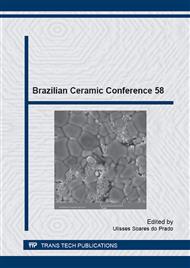[1]
T.C.C. Caldas, A.S.C. Morais, S.N. Monteiro, C.M.F. Vieira: Mater. Sci. Forum Vols. 727-728 (2012), p.999.
Google Scholar
[2]
R.H. Doremus: Glass Science. (John Wiley & Sons Ltd, 2nd ed. New York, 1994).
Google Scholar
[3]
Plano Nacional de Eficiência Energética - PNEf (in Portuguese) Premisses and Basic Directives, Brazil 2011. Available at http: /www. mme. gov. br/mme/galerias/arquivos/PlanoNacEfiEnergetica. pdf.
Google Scholar
[4]
MME - Ministério de Minas e Energia (Ministry of Mining and Energy) Interministry Decree 1. 008, de 31 de dezembro de 2010 – Program of Compact Fluorescent Lamps Brazilian Federal Official Daily Newspaper 4, January 6, 2011, ISSN 1677-7042. (In Portuguese).
Google Scholar
[5]
T.C. Shutt, J.H. Abrahams, H.H. Campbell: American Ceramic Society Bulletin Vol. 51 (1972), p.670.
Google Scholar
[6]
N.F. Youssef, M.F. Abadir, M.A.O. Shater: Journal of the European Ceramic Soc. Vol. 18 (1998), p.1721.
Google Scholar
[7]
F. Mattencci, M. Dondi, G. Guarini, Effect of soda-lime glass on sintering and technological properties of porcelain stoneware tiles, Ceramic International 28 (2002) 873-880.
DOI: 10.1016/s0272-8842(02)00067-6
Google Scholar
[8]
A.C. Morelli, J.B. Baldo: Ceramica Industrial Vol. 8 (2003), p.42.
Google Scholar
[9]
S.R. Bragança, C.P. Bergmann: J. European Ceramic Soc. Vol. 24 (2004), p.2383.
Google Scholar
[10]
K.O. Godinho, J.N.F. Holanda, A.G.P. Silva: Ceramica Vol. 51 (2005), p.419.
Google Scholar
[11]
Y. Pontikes, A. Christogerou, G.N. Angelopoulos, E. Rambaldi, A. Tucci, L. Espósito: Glass Technology Vol. 46 (2005), p.200.
Google Scholar
[12]
Y. Pontikes, L. Espósito, A. Tucci, G.N. Angelopoulos: J. European Ceramic Soc. Vol. 27 (2007), p.1657.
Google Scholar
[13]
C.M.F. Vieira, S.N. Monteiro: Rev. Materia Vol. 14 (2009), p.881.
Google Scholar
[14]
E. Furlani, G. Tonello, S. Maschio, E. Aneggi, D. Minichelli, S. Brucknera, E. Lucchini: Ceramics International Vol. 37 (2011), p.1293.
DOI: 10.1016/j.ceramint.2010.12.005
Google Scholar
[15]
D. Eliche-Quesada, C. Martínez-García, M.L. Martínez-Cartas, M.T. Cotes-Palomino, L. Pérez-Villarejo, N. Cruz-Pérez, F.A. Corpas-Iglesias: Applied Clay Science Vol. 52 (2011), p.270.
DOI: 10.1016/j.clay.2011.03.003
Google Scholar
[16]
N. Marinoni, D. D'Alessio, V. Diella, A. Pavese, F. Francescon: Journal of Environmental Management Vol. 124 (2013), p.100.
Google Scholar
[17]
L. Zhang: Construction and Building Materials Vol. 47 (2013), p.643.
Google Scholar
[18]
S.N. Monteiro, C.M.F. Vieira: Constr. Build. Mater. Vol. 68 (2014), p.599.
Google Scholar
[19]
American Society for Testing and Materials - ASTM. Water Absorption, Bulk Density, Apparent Porosity, and Apparent Specific Gravity of Fired Whiteware Products, C 373-72, USA, (1972).
DOI: 10.1520/c0373-88r06
Google Scholar
[20]
American Society for Testing and Materials - ASTM. Flexural Properties of Ceramic Whiteware Materials, C 674-77, USA, (1977).
Google Scholar
[21]
A.R. Migliore Jr., Zanotto: Ceramica Vol. 38 (253) (1992), p.7.
Google Scholar
[22]
Brazilian Association for Technical Norms. Ceramic components - Ceramic roof tiles - Terminology, requirements and testing methods. Rio de Janeiro: ABNT 2009. (NBR 15310/2009). (In Portuguese).
Google Scholar
[23]
Brazilian Association for Technical Norms. Ceramic components Part 1: Hollow ceramic blocks for non load-bearing masonry - Terminology and requirements. Rio de Janeiro: ABNT 2005. (NBR 15270-1) (In Portuguese).
Google Scholar
[24]
P.S. Santos: Science and Technology of Clays. (Edgard Blucher2nd ed., vol. 1, São Paulo, 1989).
Google Scholar
[25]
W.D. Kingery: Introduction to Ceramics. (John Wiley & Sons, New York, 1975).
Google Scholar


